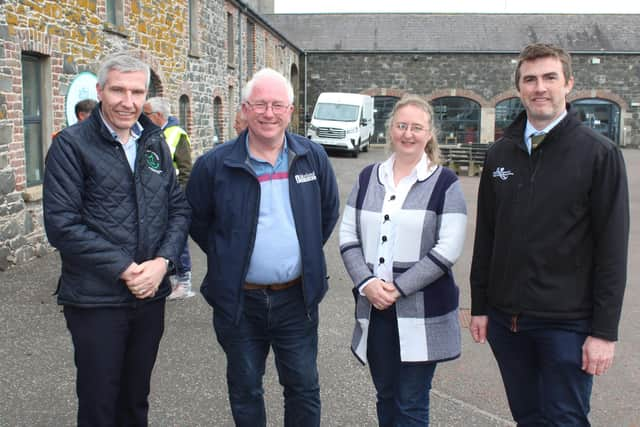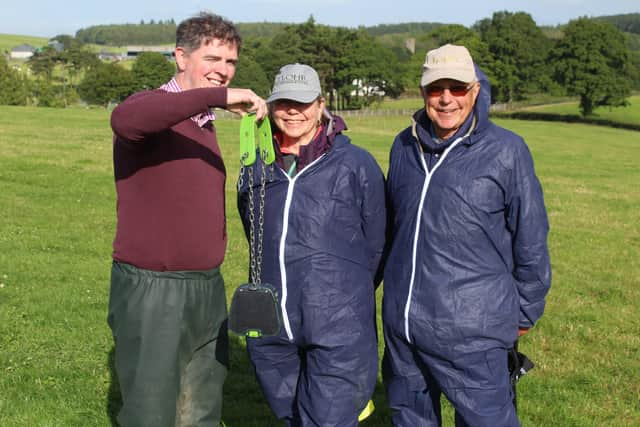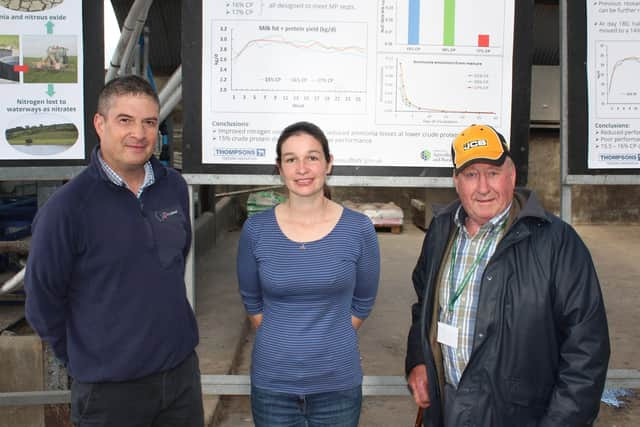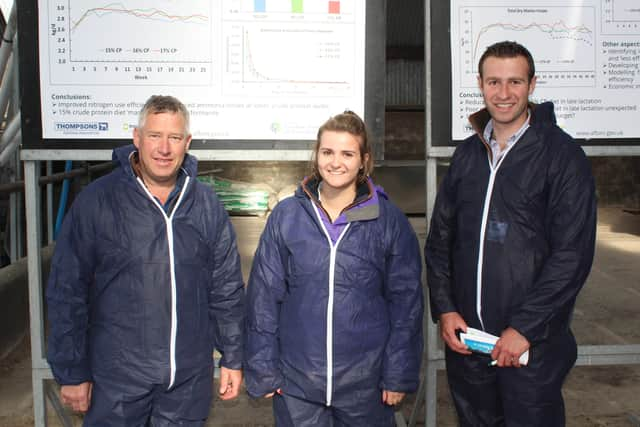BGS members receiveAFBI research update
and live on Freeview channel 276
The event provided AFBI scientists with an opportunity to profile a selection of their current research projects.
One of these relates to the development of strategies to improve nitrogen use efficiency by dairy cows.
Advertisement
Advertisement
Dairy cattle diets contain nitrogen, mostly in the form of protein. However, nitrogen use efficiency by these animals is low with only approximately 30% of nitrogen (N) that is consumed being converted into milk protein.


Much of the remaining nitrogen is excreted in manure: this has a number of implications.
In the first instance, N is lost from manure (during housing, during manure storage and during field spreading) in the form of ammonia gas, and when deposited on sensitive habitats this can lead to biodiversity loss and soil acidification.
Ammonia from manures can react with pollutants in the atmosphere to form fine particles, and these can cause respiratory problems in humans.
Advertisement
Advertisement
N in manure can also be lost as nitrous oxide. This is a potent greenhouse gas with a global warming potential almost 300 times greater than carbon dioxide.


N losses from manure to watercourses, primarily via leaching, can cause nutrient enrichment of fresh and coastal waters.
Moreover, protein is generally the most expensive component of dairy cows diets, so inefficient use of dietary nitrogen represents an economic loss. In addition, growing protein feeds such as soya bean threaten sensitive ecosystems in some parts of the world.
The current AFBI work will review existing scientific literature to identify the following: relationships between dietary protein and ammonia excretion from manures, recent research on protein feeding, protein feeding systems adopted in Europe, and approaches to assess the protein status of cows based on the analysis of milk, blood and manure.
Advertisement
Advertisement
In addition, the research will encompass an extensive data modelling exercise to examine drivers of nitrogen use efficiency in dairy cows, with this work involving data collected from approximately 40 studies conducted at AFBI over the last 25 years.


The project will also involve a series of full lactation studies in which the direct effect of protein nutrition on cow performance will be monitored.
These studies will also examine the effects of diet on milk and blood urea levels, ration digestibility, and the rumen microbiome.
It will seek to identify alternative approaches, such as the use of mid-infrared (MIR) analysis of milk to predict nitrogen use efficiency. The economics of adopting lower protein diets will also be examined.
Advertisement
Advertisement
BGS is a membership organisation which acts as a communication forum, through events and publications, for the profitable and sustainable use of grass and forage.


It brings together all those with an active interest in the science and practice of grass and forage production and utilisation; research workers, farmers, advisers, teachers and technical members of the agricultural industry.
BGS is in contact with farmers through its affiliated local grassland societies across the United Kingdom. These include the Ulster Grassland Society.
BGS has many active members abroad. The organisation is also a member of the European Grassland Federation.
The objectives of BGS are:
Advertisement
Advertisement
1) The improvement of economic methods of production and utilisation of grass and forage crops for the promotion of profitable agriculture.
2) The advancement of education and research in grass and forage crop production and utilisation. Publication of the results of relevant research to an international audience via a quarterly journal and academic symposia.
3) The interpretation of research and active communication of improved methods of production and utilisation to the farming community.
4) The promotion of grassland farming as an example of sustainable agriculture, which is environmentally benign and visually attractive, for the public benefit.
Advertisement
Advertisement
5) Representing members’ interests to Government by responding to consultations and identifying priorities for research.
According to the AFBI research team, there is currently considerable pressure, which will continue to increase, for the dairy sector to improve the efficiency with which dairy cows utilise dietary nitrogen.
Ongoing AFBI dairy research is also looking at the impact of feed-to-yield systems, specifically at high concentrate feeding levels.
In these systems cows are often offered a ‘basal diet’ (normally silage plus concentrates) to support the energy requirements of the cow for maintenance, plus a given milk yield (M+).
Advertisement
Advertisement
Additional concentrates are then offered to individual cows to support milk yields above those supported by the basal diet.
However, in recent AFBI studies examining feed-to-yield systems, milk fat percentage (and sometimes milk protein percentage) decreased at higher concentrate levels, and as a result, some of the potential economic benefits of these higher yielding cows were lost due to the lower milk composition payments.
Consequently, further studies have been carried out to provide a better understanding of how feed-to-yield systems operate on local dairy farms, and to examine the physical and financial performance of individual cows within these systems.
The study was conducted on 31 local dairy farms. Participating herds were predominantly Holstein-Friesian and had an average annual milk yield and concentrate input of 8,800 kg and 2.9 tonnes per cow, respectively. On all farms concentrates were offered on a feed-to-yield basis.
Advertisement
Advertisement
Analysis of the participant herds confirms that, as concentrate intakes increased, milk fat % decreased on the majority of farms, while milk protein % was relatively unaffected by concentrate intake
A further examination of the data indicated that 56% of the reduction in milk fat content could be explained by cow genetics, while the remaining 44% of the reduction was likely explained by the effects of diet.
This suggests that with higher yielding herds, farmers have placed a greater focus on milk yield than on milk composition when selecting sires. On closer examination of the results, there were a small number of farms that experienced either no, or only a small decrease in milk fat % at higher concentrate levels.
The reasons for this were unclear, and it is likely that no single factor was responsible. Nevertheless, contributing factors appear to have included: similar genetic potential for milk fat % across all cows in the herd, the inclusion of alternative forages in the diet, lower than average concentrate intakes, and diets with slightly lower starch contents.
Advertisement
Advertisement
The impact of this reduction in milk fat content has a significant effect on the economics of milk production, based on the typical composition payments on offer in Northern Ireland.
For cows with a concentrate intake of between 6 – 8 kg/day, there was a bonus of 2.3 pence per kg of milk produced, while at a concentrate intake of 16 - 18 kg/day, there was a deduction of 0.1 pence per kg milk.
AFBI scientists point out that these are average values: the impact of increasing concentrate levels on the milk composition of some individual cows can be much greater.
Dairy farmers are being encouraged to use their milk recording data in order to examine the milk composition of the highest yielding cows in the herd, as some individual high yielding cows may be producing milk with very poor composition.
Advertisement
Advertisement
But what about the quality of the forages fed to dairy cows and their impact on milk output?
During the last 20 years AFBI have analysed more than 70,000 separate silage samples from farms around Northern Ireland.
While the dry matter of silages analysed have increased gradually over time, other indicators of quality have shown little evidence of improvement.
For example, silage digestibility which is one of the key indicators of nutritive value has not improved.
Advertisement
Advertisement
These findings have been one of the main reasons behind AFBI scientists re-focussing their attention on silage quality.
And there is already evidence to confirm that multiple cutting regimes do offer the prospect of significantly boosting forage digestibility levels.
AFBI scientists carried out a survey among 174 dairy farmers about their silage making systems and their perceptions of the factors affecting silage quality.
The results confirm that 22% of the sample farms were taking two cuts, 65% three cuts, and 13% four or five cuts.
Advertisement
Advertisement
However, more frequent cutting will result in higher quality silage, although costs will be higher.
Early AFBI research has shown that digestibility drops by around three - 5% each week after ear emergence, and that livestock performance from early cut grass is superior.
Moving from a two or three cut system to a multi-cut system will certainly result in higher quality grass silage.
However, multi-cut systems tend to have lower total yields, while silage intakes will be higher. This could potentially increase the requirement for land by approximately 20% unless action is taken to maximise yields from existing land.
Advertisement
Advertisement
Ongoing research work at Hillsborough will look further at multi-cut systems both in the context of quality and how they can integrate with other management practices such as the timing and application of slurry between cuts.
Managing suckler cows and calves through the use of virtual fencing is a main plank of the beef research work ongoing at AFBI Hillsborough.
Courtesy of the technique, a grazing animal wears a GPS collar unit which plays an audible melody and if necessary, emits an electric pulse to the neck to deter the animal from crossing a virtual boundary. A grazing area or pasture is created using a mapping app which then communicates with the collar on the animal. When the animal approaches the Nofence boundary, the collar emits the audio melody warning to deter it from crossing the line.
The signal resembles a scale of tones, starting at a low pitch and rising gradually as the animal approaches the Nofence boundary.
Advertisement
Advertisement
The animal will recognise this tone scale, turn, and go back to the Nofence pasture to avoid the electric pulse.
According to AFBI, the GPS collars cost around £60. And, given the experiences notched up over the past 12 months, staff members at Hillsborough are confirming very positive results.
A case in point was the successful use of collars last year to allow suckled calves specifically access meal while still on their mothers.
Collars can either be purchased or hired out for a grazing season. There is also a subscription fee relating to the use of the associated app.
Advertisement
Advertisement
All the software is stored on ‘the cloud’. As a result, there is no need for an on-farm computer. All the management options are available courtesy of the app on the phone.
The farmer can view the location of his stock courtesy of the app, wherever he or she is. Stock can also be moved on to their next virtual paddock remotely.